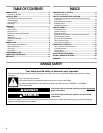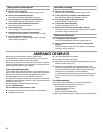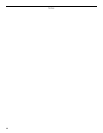
8
Bakeware
The bakeware material affects cooking results. Follow
manufacturer’s recommendations and use the bakeware size
recommended in the recipe. Use the following chart as a guide.
Oven Vent
A. Oven vent
The oven vent releases hot air and moisture from the oven, and
should not be blocked or covered. Blocking or covering the oven
vent will cause poor air circulation, affecting cooking and
cleaning results. Do not set plastics, paper or other items that
could melt or burn near the oven vent.
Baking and Roasting
IMPORTANT: To avoid damage to the interior finish, do not place
food or cookware directly on the oven door or the oven bottom.
Before baking and roasting, position the racks according to the
“Positioning Racks and Bakeware” section. When roasting, it is
not necessary to wait for the oven to preheat before putting food
in, unless recommended in the recipe.
To Bake or Roast:
1. Push in and turn the oven control knob to the desired
temperature setting.
2. Place food in oven.
The oven burner will cycle on and off to keep the oven
temperature at the setting.
3. Check food for doneness at minimum time in recipe. Cook
longer if necessary.
4. Push in and turn oven control knob to OFF when finished.
Broiling
BROILER
The broiler is located below the oven door. The broiler pan and
grid slide out for easy access. Always broil with the broiler and
oven doors closed.
■ To avoid damage to the broiler, do not step on or apply
weight to the broiler door while it is open.
■ Do not preheat broiler before use. Completely close broiler
door during broiling.
■ It is possible to broil longer cooking foods such as chicken
pieces at a lower temperature to avoid overbrowning. Turn
the knob to 400°F or 450°F, rather than Broil, for low
temperature broiling.
■ Do not use broiler cavity for storage.
■ Use only the broiler pan and grid provided with the range. It is
designed to drain juices and help avert spatter and smoke.
■ For proper draining, do not cover the grid with foil. The
bottom of the pan may be lined with aluminum foil for easier
cleaning.
■ Trim excess fat to reduce spattering. Slit the remaining fat on
the edges to avert curling.
■ Pull out oven rack to stop position before turning or removing
food. Use tongs to turn food to avoid the loss of juices. Very
thin cuts of fish, poultry or meat may not need to be turned.
■ After broiling, remove the pan from the oven when removing
the food. Drippings will bake on the pan if left in the heated
oven, making cleaning more difficult.
To Broil:
1. Open the broiler door and take out the broiler pan and grid.
2. Place food on the grid so grease can drain down into the
lower part of the broiler pan.
3. Place the pan on the broiler rack and close the broiler door.
4. Push in and turn the oven control knob to broiler position. The
temperature can be lowered at any time during the broiling by
turning the oven control knob to the desired temperature.
5. Push in and turn oven control knob to OFF position when
finished.
BAKEWARE/
RESULTS
RECOMMENDATIONS
Light colored
aluminum
■ Light golden crusts
■ Even browning
■ Use temperature and time
recommended in recipe.
Dark aluminum and
other bakeware with
dark, dull and/or
nonstick finish
■ Brown, crisp
crusts
■ May need to reduce baking
temperatures slightly.
■ Use suggested baking time.
■ For pies, breads and casseroles,
use temperature recommended in
recipe.
■ Place rack in center of oven.
Insulated cookie
sheets or baking
pans
■ Little or no bottom
browning
■ Place in the bottom third of oven.
■ May need to increase baking time.
Stainless steel
■ Light, golden
crusts
■ Uneven browning
■ May need to increase baking time.
Stoneware/Baking
stone
■ Crisp crusts
■ Follow manufacturer’s instructions.
Ovenproof
glassware, ceramic
glass or ceramic
■ Brown, crisp
crusts
■ May need to reduce baking
temperatures slightly.
A


















